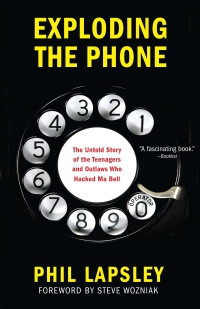EXPLODING THE PHONE
The Untold Story of the Teenagers and Outlaws Who Hacked Ma Bell
Now Available in Paperback
From Grove/Atlantic Press:

Amazon | Barnes & Noble | IndieBound | Books-A-Million
Exploding the Phone is available in hardback, paperback, and ebook forms wherever such things are sold.
TweetAn Excerpt From Chapter 9, "Little Jojo Learns to Whistle"
After high school Joe Engressia began taking classes at Dade County Junior College. Then, in the fall of 1968, he transferred to the University of South Florida in Tampa. He lived in Beta Hall, one of the dorms on campus. A little over a month into his first semester Engressia mentioned to some other students that he could whistle free long-distance calls. Yeah, right, was the response. Faced with such disbelief, Engressia responded with words that would change his life: "I can whistle like a bird and get any number you want anywhere. I'll bet you a dollar I can."
Now then, some guy offers to bet you that he can whistle you a free long-distance call, using just his lips and nothing else, it's a sure thing, right? A dollar was wagered. Whistling ensued. Engressia emerged slightly richer, his fellow students with egg on their faces. At least they got a phone call in the bargain.
Engressia's whistling trick combined two of the things he had learned ten years earlier: hook switch dialing and whistling to disconnect a call. Engressia knew that if he whistled seventh octave E, that is, 2,600 cycles per second, he could disconnect a long-distance phone call. But then what? Engressia figured out that by whistling short bursts of 2,600 Hz he could mimic the telephone company's single-frequency (SF) dialing system, just like others had figured out before him. To dial the area code 212, for example, Engressia would whistle two quick bursts of 2,600, followed by one quick burst, followed by two more quick bursts: beep beep ... beep ... beep beep! So the entire dance went like this. First, dial a call to a free long-distance number, such as directory assistance. Then give one long whistle to reset the long-distance trunk. Then whistle the pulses that made up the ten-digit phone number, one digit -- and one pulse -- at a time. it was simply the whistling equivalent of the hook switch dialing he had learned as a little kid.
The trick gained him popularity. "The guys in the dormitory were calling me 'The Whistler.' Crowds of up to forty people would follow me around," he said. The students "begged me to make the calls." Engressia obliged, charging $1 for a whistled long-distance call to anywhere in the United States. Though it's not quite a free call at that point, Engressia's rates were still a bargain compared to AT&T's, which were then about $2.60 for a five-minute cross-country call -- roughly $17 today.
While attempting to whistle a call to Long Island, New York, he "whistled wrong" and wound up connected to an operator in Montreal, Canada. This was an easy mistake to make. Long Island is area code 516, Montreal is area code 514; screw up by just two little beeps and you wind up two hundred miles north. Nonetheless, Engressia managed to convince the operator to connect him to the New York number. But the operator "was suspicious and monitored the call. Naturally the student I put the call through for talked extensively about the 'whiz kid' who had placed his free call," he said. "The operator broke in and managed to get the student to identify himself and where he was calling from."
An investigation ensued ...